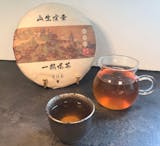Fuding Gongmei white tea from 2010
Aroma: woody, fruity like dried plums and dried figs, a little bit spicy like cinnamon, herbaceous like summer hay
taste: very sweet like fresh cane sugar and fruity like ripe fruits, cooked fruits or dried fruits
consistency: very soft and jelly-like when brewed with water at 90 ° C;
slightly drier after swallowing when brewed with boiling water (the sweetness is enhanced with boiling water).
Energy of tea: strong. I personally felt lightness and cosiness after 4 infusions, and Vito and Eunji also had a similar feeling, who tried the tea with me on a sunny afternoon in late summer.
What is Gongmei White Tea?
Gongmei is a white tea with mostly large, ripe leaves and a small proportion of tea buds. According to a new national Chinese standard dated May 1st, 2018, Gongmei must be made from a native tea variety from Fujian called Xiao Cai Cha or Qun Ti Zhong, while other white teas from Fuding such as Silver Needle, Pai Mu Tan and Shou Mei can be made from the native variety or a modern variety called Da Bai Hao.
Gongmei white tea before May 1st, 2018 was only a term for the quality class of white tea, which means that the tea has a slightly lower quality class than Pai Mu Tan and a higher quality class than Shoumei (the quality levels from high to low are Silver Needle , Pai Mu Tan, Gongmei, Shoumei) and it could be of the Da Bai Hao variety or Xiao Cai Cha, the native variety.
This Gongmei 2010 is made from the native Xiao Cai Cha / Qun Ti Zhong variety produced.
Making an aged white tea
Chinese traditional method (Kungfucha / Gongfucha):
-
90-100 ° C water
- 6-8 g for 200 ml
- 30 seconds for the first infusion, 20 seconds for the later infusions
- This Gongmei can be prepared Gongfucha style about 8 times.
Traditional European method:
-
90-100 ° C water
- 6-8 g for approx. 800 ml
- Let it steep for 2-3 minutes






